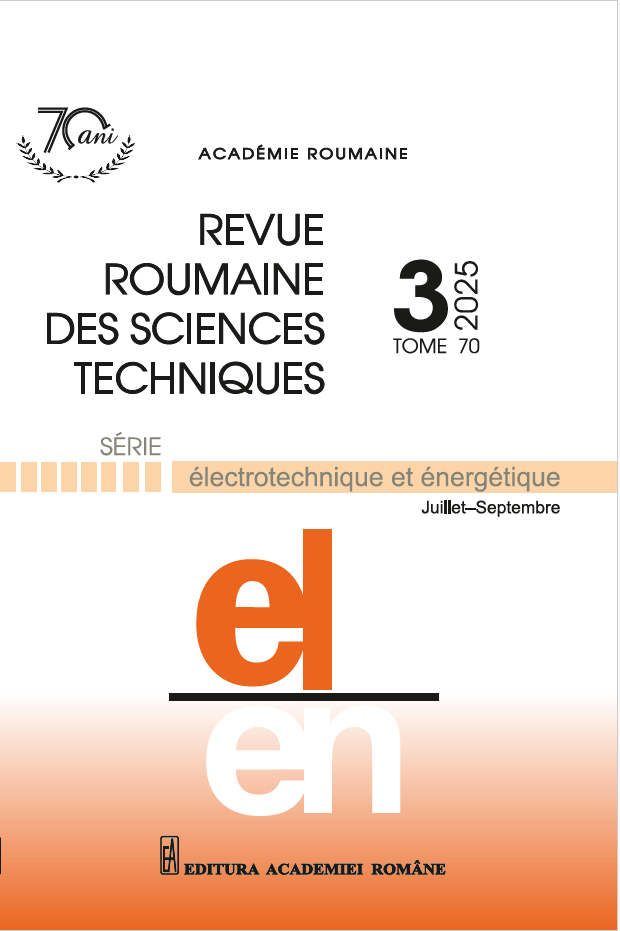SYNTHETIC OPERATIONAL DATA GENERATION FOR DEEP LEARNING APPLICATIONS IN POWER TRANSMISSION LINES
DOI:
https://doi.org/10.59277/RRST-EE.2025.3.2Keywords:
Conditional tabular generative adversarial network (CTGAN), Fault detection, Principal component analysis (PCA), Synthetic data generationAbstract
Deep learning (DL)-based protection algorithms for power transmission lines require large volumes of operational data for accurate training. However, such data is often complex to access due to confidentiality, restrictions, and proprietary limitations. This paper proposes a synthetic data generation method that combines principal component analysis (PCA) with a conditional tabular generative adversarial network (CTGAN). PCA reduces the dimensionality of high-frequency time-series data, allowing CTGAN to operate efficiently while retaining essential statistical characteristics. The generated synthetic data shows strong correlation with real data and effectively augments limited datasets. Validation using an LSTM-based fault classification model demonstrated an improvement from 50.93% to 86.07% accuracy. Additional validation using sub-synchronous oscillation data demonstrates broader applicability. The proposed method is scalable and supports DL training in data-scarce scenarios.
References
(1) M.S. Uddin, et al., On the protection of power system: Transmission line fault analysis based on an optimal machine learning approach, Energy Reports, 8, pp. 10168–10182 (2022).
(2) K. Chen, C. Huang, J. He, Fault detection, classification and location for transmission lines and distribution systems: a review on the methods, High Voltage, 1, 1, pp. 25–33 (2016).
(3) A. Mukherjee, P. K. Kundu, A. Das, Transmission line faults in power system and the different algorithms for identification, classification and localization: a brief review of methods, Journal of The Institution of Engineers (India): Series B, 102, 4, pp. 855–877 (2021).
(4) C. Janiesch, P. Zschech, K. Heinrich, Machine learning and deep learning, Electronic Markets, 31, 3, pp. 685–695 (2021).
(5) D.E. Rumelhart, G.E. Hintont, Learning Representations by Back–Propagating Errors, Cognitive Modeling, The MIT Press, 2, pp. 3–6 (2002).
(6) C. González García, E. Núñez–Valdez, V. García–Díaz, C. Pelayo G–Bustelo, J. M. Cueva–Lovelle, A review of artificial intelligence in the internet of things, International Journal of Interactive Multimedia and Artificial Intelligence, 5, 4, p. 9 (2019).
(7) A. Gulli, P. Sujit, Deep Learning with Keras, Packt Publishing Ltd (2017).
(8) Y. Lecun, Y. Bengio, G. Hinton, Deep learning, Nature, 521, 7553, pp. 436–444 (2015).
(9) R. Wason, Deep learning: Evolution and expansion, Cogn Syst Res, 52, pp. 701–708 (2018).
(10) Y. Bengio, Y. Lecun, G. Hinton, Deep learning for AI, Commun ACM, 64, 7, pp. 58–65 (2021).
(11) S.R. Fahim, S.K. Sarker, S.M. Muyeen, S.K. Das, I. Kamwa, A deep learning based intelligent approach in detection and classification of transmission line faults, International Journal of Electrical Power & Energy Systems, 133, p. 107102 (2021).
(12) S.R. Fahim, Y. Sarker, S.K. Sarker, M.R.I. Sheikh, S.K. Das, Self-attention convolutional neural network with time series imaging-based feature extraction for transmission line fault detection and classification, Electric Power Systems Research, 187, p. 106437 (2020).
(13) F. Rafique, L. Fu, M. Hassan Ul Haq, R. Mai, Automatic features extraction by transfer learning for transmission line protection, Rev. Roum. Sci. Techn. – Électrotechn. Et Énerg., 68, 4, pp. 339–344 (2023).
(14) F. Rafique, L. Fu, R. Mai, End–to–end machine learning for fault detection and classification in power transmission lines, Electric Power Systems Research, 199, p. 107430 (2021).
(15) B.P. Bhattarai, et al., Big data analytics in smart grids: state–of–the–art, challenges, opportunities, and future directions, IET Smart Grid, 2, 2, pp. 141–154 (2019).
(16) L. Xu, M. Skoularidou, A. Cuesta–Infante, K. Veeramachaneni, Modeling tabular data using conditional GAN, Adv Neural Inf Process Syst, 32 (2019).
(17) I. Goodfellow, et al., Generative adversarial networks, Commun ACM, 63, 11, pp. 139–144 (2020).
(18) I. Goodfellow, et al., Generative Adversarial Nets, Advances in neural information processing systems, Curran Associates, Inc. (2014).
(19) T. Karras, T. Aila, S. Laine, J. Lehtinen, Progressive growing of GANs for improved quality, stability, and variation, 6th International Conference on Learning Representations, ICLR, pp. 1–26 (2018).
(20) H. Abdi, L.J. Williams, Principal component analysis, Wiley Interdiscip Rev Comput Stat, 2, 4, pp. 433–459 (2010).
(21) F. Zhang, J. Li, J. Liu, W. Gao, J. He, An improved interpolated DFT–based parameter identification for sub–/super–synchronous oscillations with Synchrophasors, IEEE Transactions on Power Systems, 38, 2, pp. 1714–1727 (2022).
(22) F. Zhang, Simulated synchrophasors in SSOs and phasor measurement data recorded during a subsynchronous oscillation incident in an actual power system, IEEE DataPort, 255, 15, pp.:6989-6994 (2025).
Downloads
Published
Issue
Section
License
Copyright (c) 2025 REVUE ROUMAINE DES SCIENCES TECHNIQUES — SÉRIE ÉLECTROTECHNIQUE ET ÉNERGÉTIQUE

This work is licensed under a Creative Commons Attribution-NonCommercial-NoDerivatives 4.0 International License.


